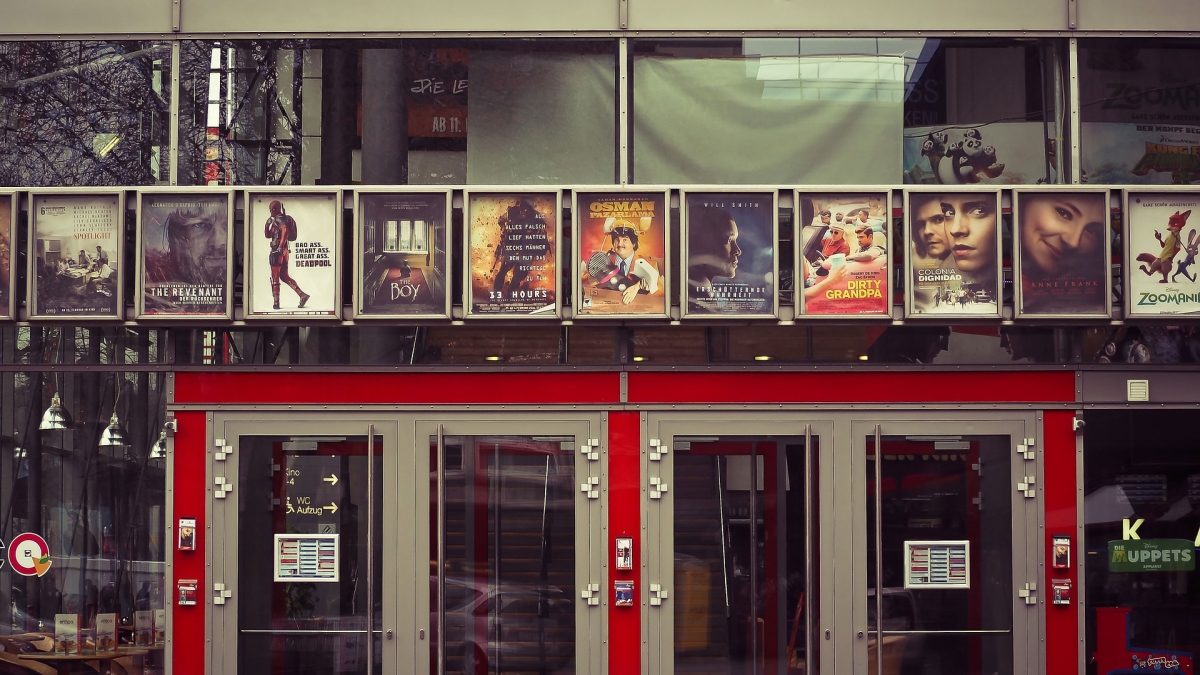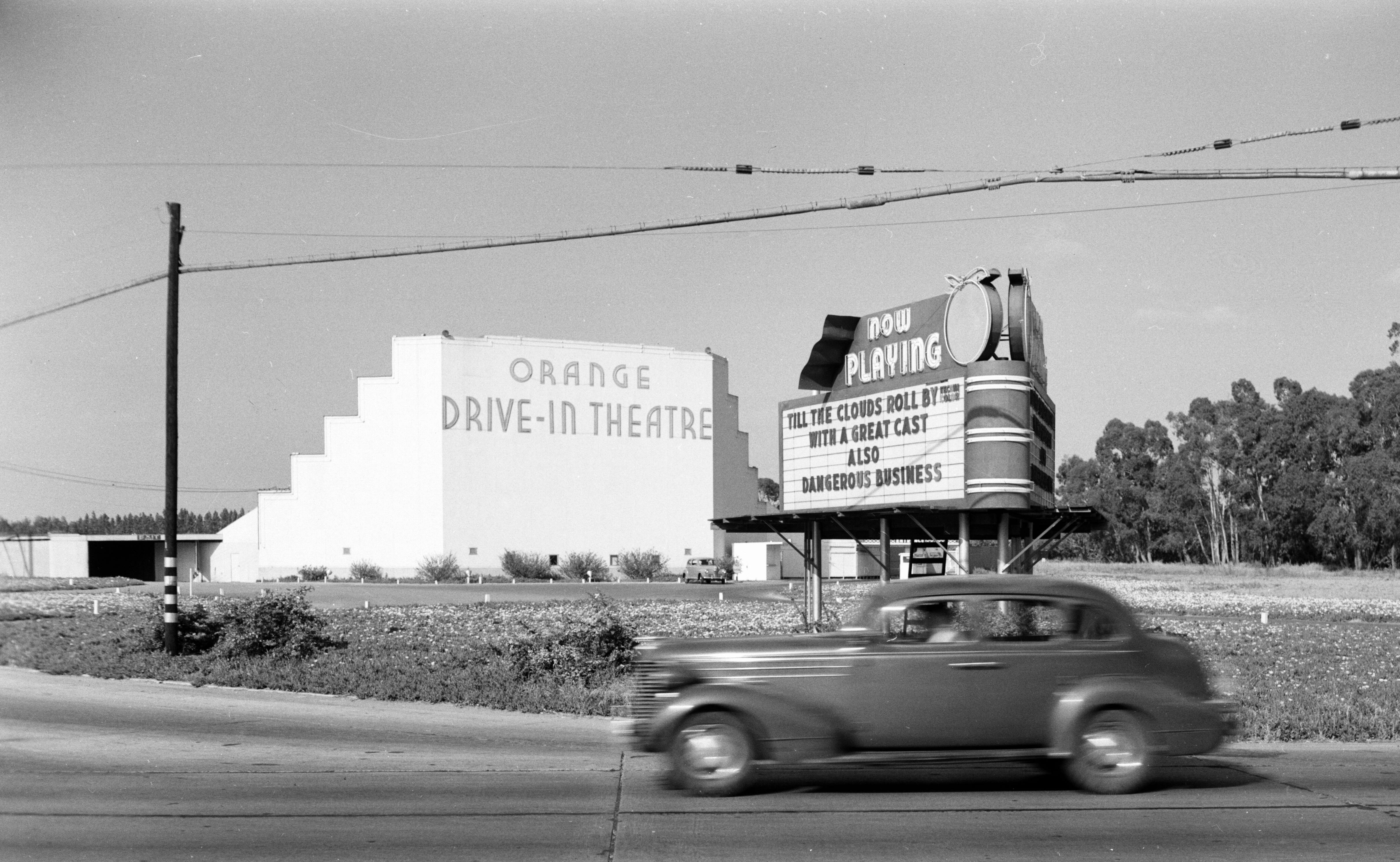From the dusk of the drive-in to the dawn of the login, America’s movie-watching journey has traversed a twisty plot of romance, drama, enterprise and disruption in the decades since the first “Automobile Movie TheatreRichard Hollingshead Jr. opened the first “Automobile Movie Theater,” which would later be called a drive-in, in Camden, New Jersey, in 1933.” offered a new way for fans to enjoy the movies on the big screen.
Drive-in theaters delivered more than just movies to audiences in their heyday. These outdoor exhibitions would sometimes include colorful sideshows such as pony rides, bingo contests, dance floors and even laundry serviceCited in Rodney Luther’s study “Marketing Aspects of Drive-in Theaters” published in the Journal of Marketing, Vol. 15 No. 1 (Jul., 1950)., luring audiences from the fancy movie palaces downtown to outdoor carnival-like theaters that were multiplying in America’s bourgeoning suburbs. Drive-in theater owners were very successful — for a while.
Photo courtesy Orange County Archives/Wikimedia
When movie lovers turned their focus to newfangled technology like television, videocassette recorders and digital streaming services to watch their flicks, the movie house and the drive-in found common misery in falling attendance. Theater operators — indoor and outdoor — had to find creative ways to bring audiences back into public view — and make money. The challenge persists today.
“People, now more than ever, have a wide range of choices in cost and platforms to watch movies,” said Kevin Sandler, an associate professor in the Film and Media Studies program at Arizona State University. “We are seeing fewer ticket sales at the movie box office because of these choices, and so the question is, ‘How do you get people to pay more money to go to a movie?’”
We asked that same question and more of Sandler in a recent Q&A for ASU Now.
Question: The year is not quite over, but it seems that we are seeing a repeat of 2017 when it comes to revenue and attendance at the movie box office — profits are up but fewer people are buying into the theater experience. What is happening, and how are theater operators addressing this shift in movie attendance?
Answer: How much money theaters make is definitely more important than how many tickets they sell. Exhibitors make a large chunk of their money through concessions and everything that is around the movie rather than a percentage of that ticket price. That puts the pressure on owners and operators to tap into their local communities to try to get people to come to the theater. This is not dissimilar to some of the shifts in exhibition that happened with the introduction to the drive-in where there was a variety of activities around the theater that targeted different groups. At some drive-in theaters during the 1950s, you could bring your laundry; there would be swing sets and hayrides. Drive-in owners also promoted the outdoor theater as a solution to the parking and babysitter problem for families. It was also a place where people could mix and mingle before, during and after the movies.
Exhibitors today have an even greater challenge in luring moviegoers back to the theaters with so many platforms available to potential ticket buyers. One of the things you see is movie theaters and movie chains tapping into the community just as they had during the Golden Age of Hollywood. In those days, the Hollywood studios encouraged local movie theater owners to create marketing buzz in their cities or towns to sell a movie. Such advertising, known as ballyhoo, was accomplished through dazzling marquees, street hawkers, parades, star appearances, partnerships with other merchants and other gimmicks.
Playgrounds and babysitting services are now popping up in some of the big indoor theater chains, and we have seen the rise of dine-in theaters, some of which offer full dinner and cocktail menus alongside conventional movie snacks like popcorn and soda. Harkins Theatres in Phoenix recently brought in live aerialists and jugglers for a showing of the movie “The Greatest Showman,” and Alamo Drafthouse Cinema in Tempe has partnered with ASU’s film school to bring classroom lectures on films to the movie theater. So the trick for an exhibitor is to make their movie house a destination beyond the blockbusters that come and go throughout the year.
Q: The growth of these destination movie houses is expanding but at an increased price point for moviegoers. Is there a concern among exhibitors that the high cost of creating new activities for moviegoers might see more drop-off in movie attendance, especially among those who don’t have much in the way of disposable income?
A: I don’t think it diminishes access for moviegoers. I think it does what the old studio system did from the 1920s into the mid-1950s. They had what was called the run zone clearance system, which allowed a film to pass through various regions and markets — from the urban to the rural, to the movie palace to the drive-in, from downtown to the suburbs. It was always class-based, hierarchized ticket prices. So if you wanted to see a new release, you would have to pay a pretty penny to see it downtown, or you could wait several months for its next run in second or third run in theaters that were not as nice as the theater downtown. You had choices. Some people do not have that choice, and to them this whole wine-and-dine theater experience doesn’t matter as smaller cities and rural towns generally will have more traditional theaters.
In this modern model of the run zone clearance system, first run now is the movie theater; the second run could be Netflix, Amazon or Redbox; and third run may be the cable networks. It gives people with expendable income the ability to make a decision about when and where they want to see a movie. The focus now is for the major Hollywood studios to provide good enough content — blockbuster-worthy content — in order for people to buy into this economic logic and the first-run theater-going experience alongside exhibitors trying to make additional money outside of box office ticket sales.
Exhibitors used to make more money because the longer a movie stayed in theaters, the larger a percentage exhibitors would get from the ticket price. Nowadays, movies come and go; they don’t sit as long and the studios are demanding larger percentages, especially for blockbusters. Studios control the pipeline so exhibitors have to find ways to create experiences for moviegoers. The logic seems to be, "If we are not filling the seats the old way, let’s start ripping up the old seats and put in new, comfortable seats and food to enhance the movie-watching experience in theaters because we simply can’t make the money off of the ticket price point."
Kevin Sandler
Q: The competition between exhibitors and on-demand services is now going head-to-head with Netflix, experimenting with the same-date release of original films like the Will Smith sci-fi fantasy “Bright” (2017) and the Sandra Bullock thriller “Bird Box” (2018) — in both theaters and via Netflix. What might this mean for the movie-going experience going forward?
A: I think it's still too early to say what, if any, impact simultaneous releases in theaters and VODvideo on demand services like Netflix will have on the future of the movie-watching experience. The value of the exclusive theatrical window is still essential for franchises and still important to directors and movie stars. When building global franchises, the major Hollywood studios will choose the largest, most conspicuous, spectacular mass medium to launch their product — and that is theatrical motion picture exhibition. Because of the importance of the launch of a franchise in this manner, exhibitors will be relatively safe for the foreseeable future.
In my opinion, Netflix’s simultaneous release of “Bright” to a handful of theaters in 2017 did not do much in terms of affecting the theatrical movie-going experience. In fact, many industry websites don’t even list the film as a theatrical release, even with the low number of theaters at which it screened. What it may mean for the movie-watching experience on the small screen via Netflix is a whole other thing. With 11 million streaming viewers in its first three days on Netflix, “Bright’s” release does suggest that people are willing to watch the opening-weekend premiere of a movie by big-name actors and big-name directors on the small screen, just as they would watch on the big screen. The success of “Bright” may suggest that consumers may not discriminate between the big screen and the small screen for similar content and that blockbusters don’t necessarily need the big screen to be blockbusters.
I don’t think you will see the impact of simultaneous releases on any significant level until the studio members of the Motion Picture Association of America get involved in exhibition again. Concerns about the studios’ monopoly of the movie business led the U.S. Supreme Court to compel the major studios to divest themselves from theater ownership at the end of the landmark antitrust case U.S. v. Paramount Pictures, Inc. in 1948. The court did not outlaw studio ownership of theaters, just certain monopolistic practices associated with it. Nevertheless, the studios divested themselves of theater chains and never really got back into the theater ownership business, despite the relaxation of some restrictions in the 1980s. Just this year, the U.S. Department of Justice Antitrust division opened a review to determine if the Paramount decrees should be modified or terminated. So, change may be coming.
Q: What role has the dominance of blockbusters played in the evolving movie-watching experience?
A: People want franchises. This is why they go to the movies — as long as the movies are good, as long as they deliver. Hollywood doesn’t simply make movies anymore. They make franchises that can be experienced across all media and entertainment sectors: toys, videogames, television series, music, broadcast and cable television networks. It is all about horizontal and vertical integration for these global media conglomerates so the theatrical experience, and the blockbusters that accompany it, still needs to be about spectacle, bigness, importance, eventness.
Alongside the aesthetics, culture and history that we teach in our Film and Media Studies program here at ASU, we also ground our understandings of media within industry. To me, to understand American mass media, you have to first and foremost approach it as a product and understand that the interaction between executives, artists, agents is really all about making the numbers work. Some of our students get a firsthand look at this interaction through the internships we have created at the Sundance Film Festival over the past eight years. It has been a valuable experience for students who have been able to use it as an immediate launching pad for their own careers in the film industry and one of the first things potential employers want to talk to our students about once they have seen their resume.
The 2019 Sundance Film Festival will host screenings in Park City, Utah, from Jan. 24-Feb. 3, 2019. Students in the Film and Media Studies program in ASU's Department of English will serve as volunteers during the second half of the 10-day festival. The 2019 film fest will also see the screenings of three films produced by ASU Sun Devils. The movie "Official Secrets" was co-written by Associate Professor Greg Bernstein of the School of Film, Dance and Theatre in ASU's Herberger Institute for Design and the Arts. ASU alumni Michael Helfant and Alex Witherill also produced the films "Them That Follow" and "Give Me Liberty," repectively.
Top photo courtesy Pixabay
More Arts, humanities and education

‘It all started at ASU’: Football player, theater alum makes the big screen
For filmmaker Ben Fritz, everything is about connection, relationships and overcoming expectations. “It’s about seeing people beyond how they see themselves,” he said. “When you create a space…

Lost languages mean lost cultures
By Alyssa Arns and Kristen LaRue-SandlerWhat if your language disappeared?Over the span of human existence, civilizations have come and gone. For many, the absence of written records means we know…

ASU graduate education programs are again ranked among best
Arizona State University’s Mary Lou Fulton College for Teaching and Learning Innovation continues to be one of the best graduate colleges of education in the United States, according to the…




